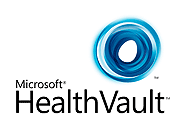Microsoft Healthvault: Coke, Pepsi or Intel Inside
Note: This post appeared originally on DiabetesMine.
When Microsoft launched its HealthVault application last year — the first major commercial Personal Health Record (PHR) system on the open web — the Wall Street Journal reported that
“Consumers are just not that excited about these services.” A year
later, I’m wondering: have they given us reason to be more excited
now? Last week, I grilled HealthVault’s rival Google Health
about the progress they are making. Are these big players trying too
hard to be all things to all people? Or, with their rather generic
“personal health platforms,” do they end up offering nothing much of
value, especially to people living with chronic illness?

This week, DiabetesMine caught up with Keith Toussaint, Senior Program Manager with Microsoft HealthVault, for a perspective from inside the Microsoft dynasty.
Keith, let’s start with consumer reaction. What has uptake been like in reality? Any big surprises?
“We haven’t faced any big surprises. We knew going in that
introducing a new type of consumer health solution is a long-term
endeavor; we have to be in this for the long haul. Health is, as you
know, a HUGE ecosystem — trillions of dollars, hundreds of millions of
consumers/patients, hundreds of thousands of physicians, thousands of
hospitals, hundreds of insurance plans and so on. We also knew the
greatest value of HealthVault to consumers will come when we can offer
connectivity throughout the health ecosystem and give people the
ability to use their personal health information in a wide range of
health and wellness applications and share it with the providers and
plans of their choice.
We’re still in the early phases of developing the HealthVault ecosystem but we’re making great progress. Please see this recent post
in which our chief architect details our progress in working directly
with hospitals, consultants, device manufacturers, and even a new service for matching consumers up with relevant clinical trials.”
So are you in a clash with Google Health over partnering with the hottest developers of online health applications?
Sure, a big part of it is a race to find the best developers. But
we’re not in some kind of hot market share battle now because it’s so
early. The idea of really managing your own health records is so new
that we still need to convince people, and give them the right tools.
We’re all trying to build a set of capabilities that’s valuable to
people.
Leading hospitals like Beth Israel Deaconess Medical Center
are actually integrating their systems with both us and Google —
because some people like one or the other. It’s a Coke or Pepsi
thing. And why not program with both? It’s fine as far as we’re
concerned; this whole space is still so small, and has such huge
potential, that we can both grow huge and succeed without bumping
heads. Later on, head-to-head competition will probably be more
important.
Here’s a question I posed to Google Health
last week: Why would any diabetic choose to store and share their
information on an open commercial platform instead of something much
more intimate and tailored to the diabetes community?
“One of the core principles we adhere to in HealthVault is the need
to richly support many healthcare scenarios, including common chronic
diseases such as diabetes and hypertension. But the fundamental
premise is that application developers will use HeathVault as a
platform for their services. We don’t even position HealthVault as
‘the place to go to manage your chronic condition,’ like diabetes.
Instead we say, ‘take a look at our application partners who’ve created
these tools…’
So once a user decides to use the Blood Pressure Management Center
application, for example, after setting up their account, all
subsequent visits will take them directly to the BP Management Center.
That is the brand. Somewhere in the corner you’ll see a logo that says
‘developed on the HealthVault platform.’”
Is your approach something like ‘Intel Inside,’ where HealthVault is the power engine behind the health applications?
“It’s not dissimilar to that. We’ve actually used the Paypal
analogy quite a bit — just like you can use Paypal to work with any
number of merchants. So when you go to PayPal.com, it takes you to the
different merchants’ services.”
I read that one recipient of the Microsoft Be Well Fund
grant program will be connecting clinical systems directly to
HealthVault to create a “proprietary diabetes management application.”
Can you tell us a little about this?
“The Be Well Fund is a Microsoft research program where we’re offering $4.5 million in funding for winning concepts for online health applications. I’d invite you to visit the page that lists the descriptions
of the proposals of the 15 winning recipients this year. They were
selected from nearly 200 proposals submitted. They’re extremely
innovative and exciting. Turns out a third of them are focusing on
diabetes.
One of the winners, the Center for Connected Health,
is working on a web-based system that integrates home-based glucose
monitoring results within the clinical workflow of diabetes care. That
means patients will use HealthVault with glucometers and blood pressure
monitors to transmit personal health information into the Partners
healthcare clinical systems and proprietary diabetes management
application.
I understand you’re also connecting patient portals from
Beth Israel Medical Center, Kaiser Permanente and other partner
institutions directly to HealthVault, so what about privacy and HIPAA
Compliance?
“If information is brought in by the patient, whether in paper or
digital form, the clinical provider has to decide whether or not to
input it into their clinic’s electronic system and use it for care.
The clear message we are communicating is that HealthVault is not to be
use by clinicians to make clinical decisions. Rather, it provides data
on their patients that they can access and review if they choose.
Beth Israel’s application will initially just transmit information
into to HealthVault. So it allows a patient, on discharge from the
hospital, to go to the portal and have their CCR (Continuity of Care Record) document sent to their HealthVault account.
The application with Kaiser is more integrated. It will involve a
two-way transfer of information. But providers will only make decisions
on information that winds up in their clinics’ HIPAA-compliant EMR
(electronic medical records) system. We’re working on ways to make the
interaction with these clinical EMR systems easier, so that importing
data is seamless and doesn’t become a burden to physicians.
As a matter of principal, using an online health record like
HealthVault is not that different than a patient filling out forms on
clipboards, but the digital format adds more value and continuity. And
the data is in the control of user. Plus we’re not relying on memory,
or whether a doctor’s handwriting is legible.”
How do your (partners’) diabetes management services stack up against those from Google Health?
“There are a number of differences between our approach and Google’s that we believe provide users with great
value. One is enabling users to share records (for example, two parents
sharing access to a single child record). As far as I’m aware, ours is
the only platform of its type that offers this capability. Also, when a
child comes of age, we offer a means for their record to be
transitioned to their complete control.
Another significant difference is our ‘granular control’ over data
access. By this I mean: I can imagine that diabetics would be happy to
share their glucose data with their endocrinologist, but should that
same data be shared with others who may have access to their health
records? We believe the consumer should be able to control this, so
we’ve made access settings an important part of our offering — while at
the same time supporting industry standards such as the Continuity of
Care Record (CCR) and the Continuity of Care Document (CCD) so that data can be transferred.

We also have a different approach on device connectivity. We’ve created a HealthVault Connection Center where we’ve written software that enables you to connect a wide range of devices — glucose meters, blood pressure monitors, heart rate monitors, pedometers, scales, and more — to auomatically transfer the data directly into your HealthVault account. We’re working hard to get
more providers on board. We believe there’s a big value in offering a
central place for people to connect a whole range of health devices —
as opposed to having to use multiple applications for various devices.”
Have you prioritized diabetes or other “popular” health conditions as your biggest development targets?
We have not. Diabetes is the largest proportion of focus among our
Be Well Fund grantees, but strictly speaking this not a market
strategy. We take the lead from our partners — the hospitals, EMR
vendors, and systems like Kaiser that tell us what they need and want.
Then we work with them to make the capabilities available on a platform
that addresses their needs. As it happens, there’s a lot of need for
diabetes management solutions.
Finally, at launch time last year, your company talked about making “a billion-plus” in revenue with HealthVault (according to Peter Neupert, who heads the Health Solutions Group). With that in mind, can you assure users that they won’t be bombarded by ads?
If you go to HealthVault.com, you will not see any ads. Like Google
in this case, our business model is search, and we have a number of
ways to integrate paid search. But your health records remain entirely
separate from that.
A search box is prominently situated on HealthVault, but when you click on it, it will send you out to MSN or our health.live.com site. We have a clear statement on privacy safeguards on our consumer and developer sites.
This brings to mind another issue: the need to ensure that we (all
of us) work as hard as we can to ensure data interoperability among
consumer-focused health platforms. We’re investing in the technology
that would allow our users to exchange data with existing services from
Google and Indivo (platform on which the Dossia service
for employer health records was created) ensuring that the consumer
remains in control of their data. We believe that, along with the focus
on device connectivity and working with partners to build innovative
applications, will give individuals a very powerful solution for
managing their care.”
****
Editor’s Note: Once again, the
company insists that user input is welcome. Have you tried accessing
the Connectivity Center, or using HealthVault for storing your diabetes
data? Here’s your chance to tell Microsoft what you think.


My old employer launched a PHR back in 2002 and it could never get traction. Maybe it was ahead of its time? Until PHRs and EMRs can pass data seamlessly, I just can't see the average consumer taking the time to keep up a PHR…even if the process is extremely quick and user-friendly. There is too much mass education that has to be done on the value of a PHR before consumers will embrace, IMHO.